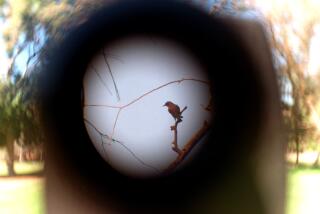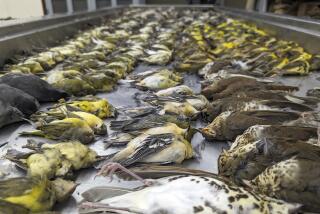‘Bird Man’ Trains Youths to Be Environmental Warriors
GRAND ISLAND, Neb. — Craig Faanes plunked down a few dollars on a desk and challenged a roomful of fifth-graders to raise money to help save the world’s rain forests. They went out and did it.
When the ornithologist suggested to tourism officials here that people around the world might be interested in seeing the habitat of half a million migrating sandhill cranes, they started an annual event that draws thousands of visitors to south-central Nebraska.
Since Faanes came to Nebraska in 1979, he has devoted much of his time to studying the Platte River and educating people--especially children--about the cranes, ducks and geese that depend on the river’s water and wetlands.
Maureen Nickels, a teacher at Wasmer Elementary School, says Faanes is a hero to her pupils. They call him the Bird Man, she said, and he calls the children “eco-warriors.”
The American Ornithologists Union recognizes Faanes as having spotted birds of the most species in North America --1,600.
The 39-year-old U.S. Fish and Wildlife Service employee, reared in Rice Lake, Wis., is diligent in his efforts raise awareness of environmental problems and the need to conserve natural resources.
Those efforts have caught attention in the White House. President Bush recently honored Faanes as one of the “1,000 Points of Light” to which he referred during his 1988 election campaign.
The award he got at the White House is nice, Faanes says, but children’s ideas are much nicer.
“I want kids to know about Mother Earth, so when I’m getting ready to retire I don’t have to sit and worry about things being as mucked up as they are,” he said recently.
Faanes got hooked on the environment at an early age. As a 6-year-old walking with his grandfather in a forest in Wisconsin, he saw a bulldozer taking down trees to make way for a road.
“I remember telling my grandpa that if people keep knocking down trees, by the time I was as old as he was there wouldn’t be any trees left,” Faanes said. “And my grandpa told me not to worry, because there would always be trees.”
When a group of students working with Faanes studied rain forests this year, they designed T-shirts and posters. They made up recipes using ingredients grown in rain forests. They also wrote to leaders of South American countries, encouraging them to come up with conservation laws and to raise awareness about destruction of the forests.
They also raised more than $1,000 to help preserve the forests.
Now Faanes is working with the National Fish and Wildlife Foundation to establish a “Children’s Rain Forest Challenge” fund, to pay for expanding the Grand Island project nationwide. The idea includes establishing a “sister school” program for exchanging conservation ideas with children in Central and South American nations.
“Just because you’re a kid doesn’t mean you can’t do anything big,” 10-year-old Frank Dobbins of the Wasmer School wrote in a letter describing the values the Bird Man has instilled in him. “Kids can make a difference.”
The President’s “1,000 Points of Light” award credited Faanes with helping to develop “Wings Over the Platte,” an annual three-day program that celebrates the migration of sandhill cranes, which pass through Nebraska every March.
Thousands of people came from as far away as Germany and Japan to see the birds this year, and about 1,000 visitors turned out for this year’s “Wings Over Platte” March 15-17.
About 80% of the world’s cranes stop at the shallow Platte River to rest and feed on their spring flight from Mexico, New Mexico and Texas to northern Canada, Alaska and Siberia.
To date, Faanes has published about 60 articles and a book, “Birds of the St. Croix River Valley.”
He follows rare birds such as the Kirtland’s warbler, which nests in northern Michigan and winters in the West Indies. He saw a resplendent, reddish-green quetzal in Costa Rica and two of the four known Zapata wrens in Cuba last year.
“It’s the best-singing wren I’ve ever stumbled onto,” he said.
But it took him 12 years to spot the Leach’s storm-petrel, a sea bird commonly seen offshore in the Atlantic and Pacific oceans.
“I spent all kinds of time at sea, off-sea,” Faanes said. “I’ve been offshore about 45 times and I never saw this damn thing.”
Finally, he saw one while on a boating trip near Alaska.
More to Read
Sign up for Essential California
The most important California stories and recommendations in your inbox every morning.
You may occasionally receive promotional content from the Los Angeles Times.










